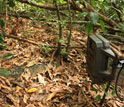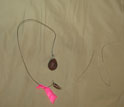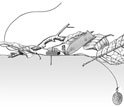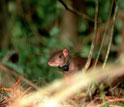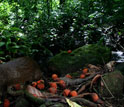News Release 12-131
Thieving Rodents: Did They Save Tropical Trees?
Rodents may have taken over seed-dispersal role of now-extinct mammals
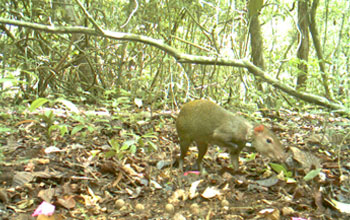
A camera-trap caught this agouti in the act of stealing seeds from another's cache.
July 16, 2012
This material is available primarily for archival purposes. Telephone numbers or other contact information may be out of date; please see current contact information at media contacts.
Big seeds produced by tropical trees such as black palms were probably once ingested and then left whole by huge mammals called gomphotheres.
Gomphotheres weighed more than a ton and dispersed the seeds over large distances.
But these Neotropical creatures disappeared more than 10,000 years ago. So why aren't large-seeded plants also extinct?
A paper published this week in the journal Proceedings of the National Academy of Sciences (PNAS) suggests that rodents may have taken over the seed-dispersal role of gomphotheres.
"The question has been: how did a tree like the black palm manage to survive for 10,000 years, if its seed-dispersers are extinct?" asks Roland Kays, co-author of the paper and a zoologist at North Carolina State University and the North Carolina Museum of Natural Sciences.
"This research solves a long standing puzzle in ecology," says Alan Tessier, program director in the National Science Foundation's (NSF) Division of Environmental Biology, which funded the research.
"How did plant species that seem to be dependent on Pleistocene megafauna for seed-dispersal survive the extinction of that megafauna?"
Now, says Kays, scientists may have an answer.
By attaching tiny radio transmitters to more than 400 seeds, Patrick Jansen, a scientist at the Smithsonian Tropical Research Institute (STRI) and Wageningen University and colleagues found that 85 percent of the seeds were buried in caches by agoutis, common rodents in tropical lowlands.
Agoutis carry seeds around in their mouths and bury them for times when food is scarce.
Radio-tracking revealed a surprising finding: when the rodents dig up the seeds, they usually don't eat them, but instead move them to a new site and bury them, often many times.
One seed in the study was moved 36 times.
Researchers used remote cameras to catch the animals digging up cached seeds. They discovered that frequent seed movement primarily was caused by animals stealing seeds from one another.
Ultimately, 35 percent of the seeds ended up more than 100 meters from their origin. "Agoutis moved seeds at a scale that none of us had ever imagined," says Jansen.
"We had observed seeds being moved and buried up to five times, but in this system it seems that re-caching behavior is 'on steroids,'" says Ben Hirsch of STRI and Ohio State University.
"By radio-tagging the seeds, we were able to track them as they were moved by agoutis, find out if they were taken up into trees by squirrels, then discover the seeds inside spiny rat burrows.
"That allowed us to gain a much better understanding of how each rodent species affects seed dispersal and survival."
By taking over the role of Pleistocene mammals in dispersing large seeds, thieving, scatter-hoarding agoutis may have saved several species of trees from extinction.
Other co-authors of the paper are Willem-Jan Emsens of Wageningen University and the University of Antwerp; Veronica Zamora-Gutierrez of Wageningen University and the University of Cambridge; and Martin Wikelski of STRI and the Max Planck Institute for Ornithology, as well as the University of Konstanz.
-NSF-
-
Camera-traps were placed at caches to determine which animals moved tropical tree seeds.
Credit and Larger Version -
Miniature transmitters, attached to seeds with an antenna, tracked dispersal by agoutis.
Credit and Larger Version -
Rodents warned scientists of seed movement by pulling the transmitter off a magnet.
Credit and Larger Version -
Radio-collars allowed researchers to follow agoutis across tropical forests in Panama.
Credit and Larger Version -
Black palm seeds, once sown by extinct megafauna, are now sown by agoutis.
Credit and Larger Version
Media Contacts
Cheryl Dybas, NSF, (703) 292-7734, email: cdybas@nsf.gov
Beth King, STRI, (202) 633-4700, email: kingb@si.edu
The U.S. National Science Foundation propels the nation forward by advancing fundamental research in all fields of science and engineering. NSF supports research and people by providing facilities, instruments and funding to support their ingenuity and sustain the U.S. as a global leader in research and innovation. With a fiscal year 2023 budget of $9.5 billion, NSF funds reach all 50 states through grants to nearly 2,000 colleges, universities and institutions. Each year, NSF receives more than 40,000 competitive proposals and makes about 11,000 new awards. Those awards include support for cooperative research with industry, Arctic and Antarctic research and operations, and U.S. participation in international scientific efforts.
Connect with us online
NSF website: nsf.gov
NSF News: nsf.gov/news
For News Media: nsf.gov/news/newsroom
Statistics: nsf.gov/statistics/
Awards database: nsf.gov/awardsearch/
Follow us on social
Twitter: twitter.com/NSF
Facebook: facebook.com/US.NSF
Instagram: instagram.com/nsfgov



